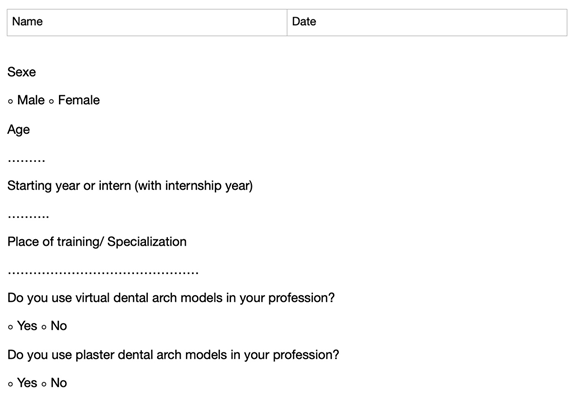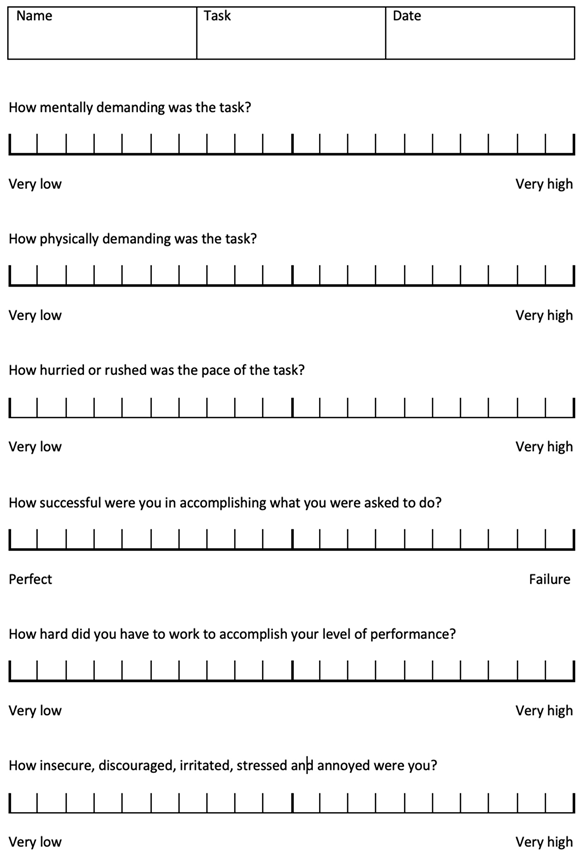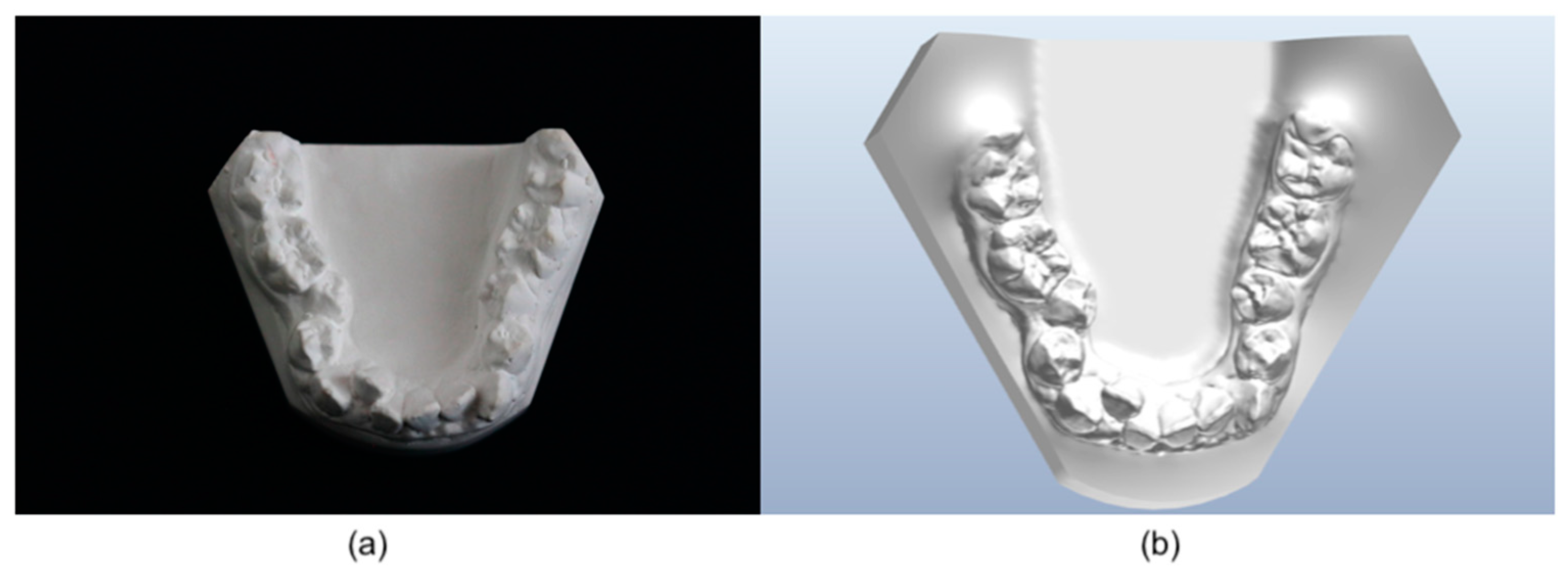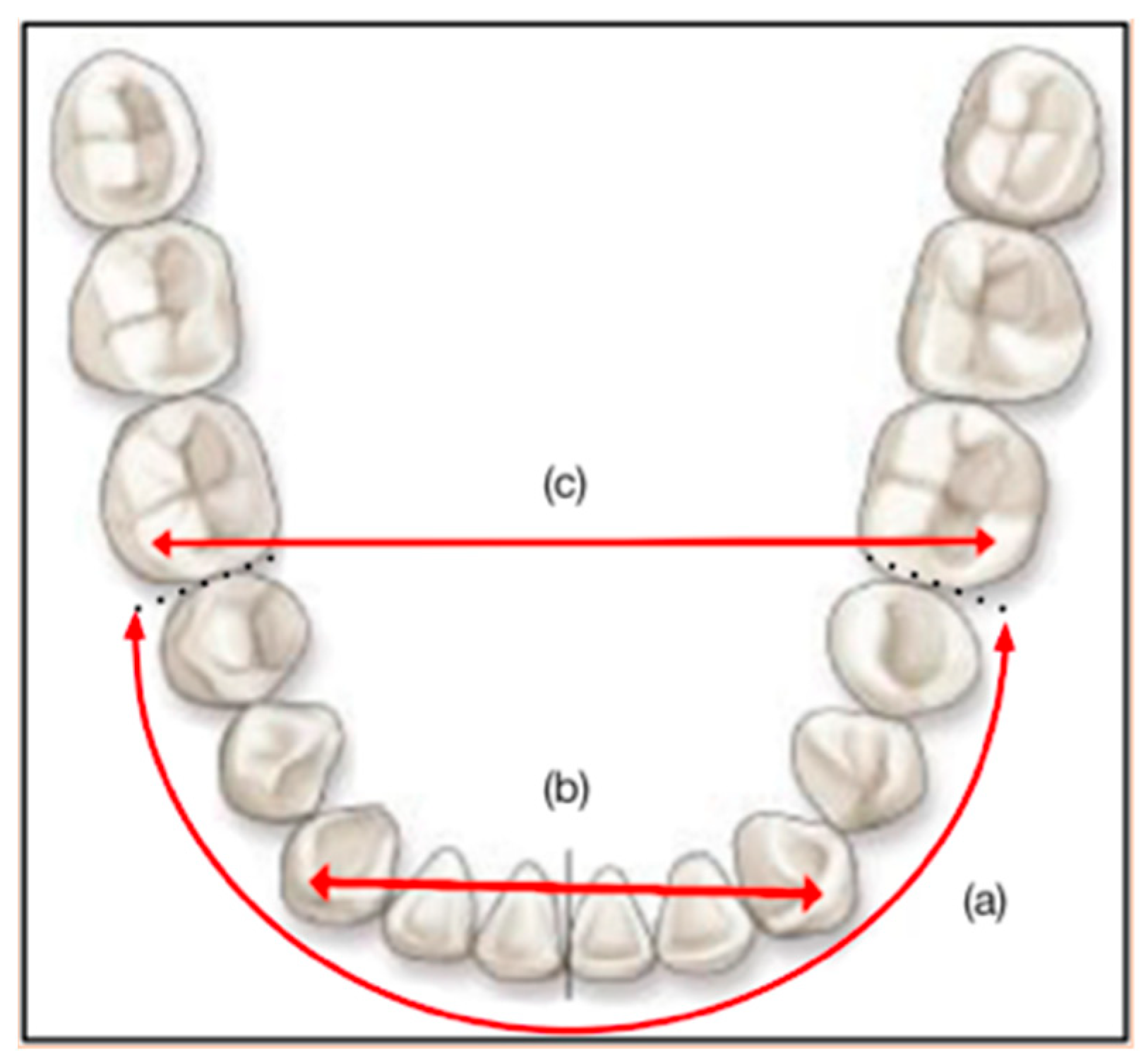Estimation of Distances within Real and Virtual Dental Models as a Function of Task Complexity
Abstract
1. Introduction
1.1. Objective Measurements of Distance Using Measurement Tools
1.2. Subjective Measurements of Distance (Estimation) without Measurement Tools
1.3. Aims
2. Materials and Methods
2.1. Subjects
2.2. Material
2.2.1. Dental Arch Models
- The DHC (Dental Health Component): morphological component of the IOTN (Index of Orthodontic Treatment Need);
- The PAR Index (Peer Assessment Rating Index);
- The DAI (Dental Aesthetic Index).
- Easy: anterior crowding only with contact point shift of 1 to 2 mm and without arch shape anomaly (normal inter-canine and inter-molar distances) or dental anomaly;
- Medium: anterior crowding resulting in a contact point shift of 2 to 4 mm with rotation or ectopia of one tooth per sector, asymmetry of less than 2 mm, and/or pathological arch shape;
- Difficult: anterior and medium crowding resulting in contact point shifts of more than 4 mm and/or ectopic positions and rotations of several teeth per sector, asymmetry greater than 2 mm, and/or pathological arch form.
2.2.2. Questionnaires
Demographic Data
Mental Load
2.3. Procedure
- Crowding is an intra-arch parameter which can be assessed on the maxillary and mandibular arches. The estimation of this distance is important in the evaluation of dento-maxillary disharmonies. In our study, we asked the participants to perform a crowding estimate only on the mandibular arch and on the 10 anterior teeth (36 mesial to 46 mesial);
- The inter-canine distance is the right transverse distance measured between the top of the right and left canine tips;
- The inter-molar distance is the straight transverse distance joining the apexes of the mesio-vestibular cusps of the first permanent molars.
2.4. Statistical Analysis
3. Results
3.1. Mental Load
- The type of presentation (real vs. virtual) (F (1, 49) = 16.778, p < 0.05): the descriptive results (Table 1) show that, for the participants, the mental load associated with estimating distances was higher for the virtual models than for the real models (all levels of complexity combined);
- The level of complexity (F (2, 98) = 5.331, p < 0.05): the descriptive results (Table 1) show that, for the participants, the mental load associated with estimating distances was the lowest in the easy condition, then increased in the medium condition, and was highest in the difficult condition (for the real and virtual conditions).
3.2. Distance Estimates
3.2.1. Mandibular Crowding and Inter-Canine Distance
- The type of presentation (real vs. virtual) (F (1, 49) = 7.662 and p < 0.05 for mandibular crowding and F (1, 49) = 6.053 and p < 0.05 for the inter-canine distance): these two distances (Table 2) were overestimated both in reality and in the virtual environment, and this overestimation was greater in the virtual conditions than in the real conditions;
- The level of complexity (F (2, 98) = 5.139 and p < 0.05 for mandibular crowding and F (2, 98) = 4.078 and p < 0.05 for the inter-canine distance): for these two estimations (Table 2), the overestimation was smaller in the difficult condition than in the easy and medium conditions.
| Modality | F | p | |
|---|---|---|---|
| Mandibular Crowding | Presentation | 7.662 | 0.008 * |
| Complexity | 5.139 | 0.008 * | |
| Interaction | 0.951 | 0.390 | |
| Inter-Canine Distance | Presentation | 6.053 | 0.017 * |
| Complexity | 4.078 | 0.020 * | |
| Interaction | 3.154 | 0.047 * | |
| Inter-Molar Distance | Presentation | 0.441 | 0.510 |
| Complexity | 1.740 | 0.181 | |
| Interaction | 1.660 | 0.195 |
3.2.2. Inter-Molar Distance
3.2.3. Effect of Experience
4. Discussion
5. Conclusions
Author Contributions
Funding
Informed Consent Statement
Data Availability Statement
Conflicts of Interest
Appendix A. Demographic Questionnaire

Appendix B. NASA-TLX Questionnaire

References
- Marcel, T.J. Three-Dimensional on-Screen Virtual Models. Am. J. Orthod. Dentofac. Orthop. 2001, 119, 666–668. [Google Scholar] [CrossRef] [PubMed]
- Kravitz, N.; Groth, C.; Jones, P.; Graham, J.; Redmond, W. Intraoral Digital Scanners. J. Clin. Orthod. JCO 2014, 48, 337–347. [Google Scholar] [PubMed]
- Hajeer, M.Y.; Millett, D.T.; Ayoub, A.F.; Siebert, J.P. Current Products and Practices: Applications of 3D Imaging in Orthodontics: Part I. J. Orthod. 2004, 31, 62–70. [Google Scholar] [CrossRef] [PubMed]
- Coblentz, J.-F. Empreintes Numériques: Mythes et Réalité Quotidienne. L’Orthod. Française 2012, 83, 81–92. [Google Scholar] [CrossRef]
- Mangano, F.; Bakaj, R.; Frezzato, I.; Frezzato, A.; Montini, S.; Mangano, C. Morse Taper Connection Implants Placed in Grafted Sinuses in 65 Patients: A Retrospective Clinical Study with 10 Years of Follow-Up. Int. J. Dent. 2017, 2017, 4573037. [Google Scholar] [CrossRef]
- Hajeer, M.Y.; Millett, D.T.; Ayoub, A.F.; Siebert, J.P. Current Products and Practices: Applications of 3D Imaging in Orthodontics: Part II. J. Orthod. 2004, 31, 154–162. [Google Scholar] [CrossRef]
- Kumar, A.A.; Phillip, A.; Kumar, S.; Rawat, A.; Priya, S.; Kumaran, V. Digital Model as an Alternative to Plaster Model in Assessment of Space Analysis. J. Pharm. Bioallied Sci. 2015, 7, 465. [Google Scholar] [CrossRef]
- Reuschl, R.P.; Heuer, W.; Stiesch, M.; Wenzel, D.; Dittmer, M.P. Reliability and Validity of Measurements on Digital Study Models and Plaster Models. Eur. J. Orthod. 2016, 38, 22–26. [Google Scholar] [CrossRef]
- Rossini, G.; Parrini, S.; Castroflorio, T.; Deregibus, A.; Debernardi, C.L. Diagnostic Accuracy and Measurement Sensitivity of Digital Models for Orthodontic Purposes: A Systematic Review. Am. J. Orthod. Dentofac. Orthop. 2016, 149, 161–170. [Google Scholar] [CrossRef]
- Radeke, J.; von der Wense, C.; Lapatki, B.G. Comparison of Orthodontic Measurements on Dental Plaster Casts and 3D Scans. Orthop./Fortschr. Kieferorthopadie 2014, 75, 264–274. [Google Scholar] [CrossRef]
- Czarnota, J.; Hey, J.; Fuhrmann, R. Measurements Using Orthodontic Analysis Software on Digital Models Obtained by 3D Scans of Plaster Casts: Intrarater Reliability and Validity. Orthop./Fortschr. Kieferorthopadie 2016, 77, 22–30. [Google Scholar] [CrossRef] [PubMed]
- Creem-Regehr, S.H.; Willemsen, P.; Gooch, A.A.; Thompson, W.B. The Influence of Restricted Viewing Conditions on Egocentric Distance Perception: Implications for Real and Virtual Indoor Environments. Perception 2005, 34, 191–204. [Google Scholar] [CrossRef] [PubMed]
- Knapp, J.; Loomis, J. Visual Perception of Egocentric Distance in Real and Virtual Environments. In Virtual and Adaptive Environments; Hettinger, L., Haas, M., Eds.; CRC Press: Boca Raton, FL, USA, 2003; pp. 21–46. ISBN 978-0-8058-3107-8. [Google Scholar]
- Messing, R.; Durgin, F.H. Distance Perception and the Visual Horizon in Head-Mounted Displays. ACM Trans. Appl. Percept. 2005, 2, 234–250. [Google Scholar] [CrossRef]
- Willemsen, P.; Gooch, A.A. Perceived Egocentric Distances in Real, Image-Based, and Traditional Virtual Environments. In Proceedings of the Proceedings IEEE Virtual Reality 2002, Orlando, FL, USA, 24–28 March 2002; pp. 275–276. [Google Scholar]
- Waller, D.; Richardson, A.R. Correcting Distance Estimates by Interacting with Immersive Virtual Environments: Effects of Task and Available Sensory Information. J. Exp. Psychol. Appl. 2008, 14, 61–72. [Google Scholar] [CrossRef]
- Sahm, C.S.; Creem-Regehr, S.H.; Thompson, W.B.; Willemsen, P. Throwing versus Walking as Indicators of Distance Perception in Similar Real and Virtual Environments. ACM Trans. Appl. Percept. 2005, 2, 35–45. [Google Scholar] [CrossRef]
- Thompson, W.B.; Willemsen, P.; Gooch, A.A.; Creem-Regehr, S.H.; Loomis, J.M.; Beall, A.C. Does the Quality of the Computer Graphics Matter When Judging Distances in Visually Immersive Environments? Presence 2004, 13, 560–571. [Google Scholar] [CrossRef]
- Witmer, B.G.; Sadowski, W.J. Nonvisually Guided Locomotion to a Previously Viewed Target in Real and Virtual Environments. Hum. Factors 1998, 40, 478–488. [Google Scholar] [CrossRef]
- Tourancheau, S.; Sjöström, M.; Olsson, R.; Persson, A.; Ericson, T.; Rudling, J.; Norén, B. Subjective Evaluation of User Experience in Interactive 3D Visualization in a Medical Context. In Medical Imaging 2012: Image Perception, Observer Performance, and Technology Assessment; Abbey, C.K., Mello-Thoms, C.R., Eds.; SPIE: Bellingham, WA, USA, 2012; Volume 8318. [Google Scholar]
- Wartenberg, C.; Wiborg, P. Precision of Exocentric Distance Judgments in Desktop and Cube Presentation. Presence 2003, 12, 196–206. [Google Scholar] [CrossRef]
- Makaremi, M. Les enjeux d’une nouvelle interface. Rev. D’orthopédie Dento-Faciale 2018, 52, 319–324. [Google Scholar] [CrossRef]
- Martin, C.B.; Chalmers, E.V.; McIntyre, G.T.; Cochrane, H.; Mossey, P.A. Orthodontic Scanners: What’s Available? J. Orthod. 2015, 42, 136–143. [Google Scholar] [CrossRef]
- Bellot-Arcís, C.; Montiel-Company, J.M.; Almerich-Silla, J.M.; Paredes-Gallardo, V.; Gandía-Franco, J.L. The Use of Occlusal Indices in High-Impact Literature. Community Dent. Health 2012, 29, 45–48. [Google Scholar] [PubMed]
- Bittner, A.C.; Byers, J.C.; Hill, S.G.; Zaklad, A.L.; Christ, R.E. Generic Workload Ratings of a Mobile Air Defense System (LOS-F-H). Proc. Hum. Factors Soc. Annu. Meet. 1989, 33, 1476–1480. [Google Scholar] [CrossRef]
- Said, S.; Gozdzik, M.; Roche, T.R.; Braun, J.; Rössler, J.; Kaserer, A.; Spahn, D.R.; Nöthiger, C.B.; Tscholl, D.W. Validation of the Raw National Aeronautics and Space Administration Task Load Index (NASA-TLX) Questionnaire to Assess Perceived Workload in Patient Monitoring Tasks: Pooled Analysis Study Using Mixed Models. J. Med. Internet Res. 2020, 22, e19472. [Google Scholar] [CrossRef] [PubMed]
- Wallis, C.; McNamara, C.; Cunningham, S.J.; Sherriff, M.; Sandy, J.R.; Ireland, A.J. How Good Are We at Estimating Crowding and How Does It Affect Our Treatment Decisions? Eur. J. Orthod. 2014, 36, 465–470. [Google Scholar] [CrossRef]
- Johal, A.S.; Battagel, J.M. Dental Crowding: A Comparison of Three Methods of Assessment. Eur. J. Orthod. 1997, 19, 543–551. [Google Scholar] [CrossRef]
- Naish, H.; Dunbar, C.; Crouch-Baker, J.; Shah, K.; Wallis, C.; Atack, N.E.; Sherriff, M.; Sandy, J.R.; Ireland, A.J. Does a True Knowledge of Dental Crowding Affect Orthodontic Treatment Decisions? Eur. J. Orthod. 2016, 38, 66–70. [Google Scholar] [CrossRef]
- Makaremi, M.; N’Kaoua, B. Estimation of Distances in 3D by Orthodontists Using Digital Models. Appl. Sci. 2021, 11, 8285. [Google Scholar] [CrossRef]
- Chao, C.-J.; Wu, S.-Y.; Yau, Y.-J.; Feng, W.-Y.; Tseng, F.-Y. Effects of Three-Dimensional Virtual Reality and Traditional Training Methods on Mental Workload and Training Performance. Hum. Factors Man. 2017, 27, 187–196. [Google Scholar] [CrossRef]
- Das, S.; Maiti, J.; Krishna, O.B. Assessing Mental Workload in Virtual Reality Based EOT Crane Operations: A Multi-Measure Approach. Int. J. Ind. Ergon. 2020, 80, 103017. [Google Scholar] [CrossRef]
- Jacko, J.A.; Ward, K.G. Toward Establishing a Link between Psychomotor Task Complexity and Human Information Processing. Comput. Ind. Eng. 1996, 31, 533–536. [Google Scholar] [CrossRef]
- Li, J.; Kim, J.-E. The Effect of Task Complexity on Time Estimation in the Virtual Reality Environment: An EEG Study. Appl. Sci. 2021, 11, 9779. [Google Scholar] [CrossRef]
- Jaquess, K.J.; Gentili, R.J.; Lo, L.-C.; Oh, H.; Zhang, J.; Rietschel, J.C.; Miller, M.W.; Tan, Y.Y.; Hatfield, B.D. Empirical Evidence for the Relationship between Cognitive Workload and Attentional Reserve. Int. J. Psychophysiol. 2017, 121, 46–55. [Google Scholar] [CrossRef] [PubMed]
- Campbell, D.J. Task Complexity: A Review and Analysis. Acad. Manag. Rev. 1988, 13, 40–52. [Google Scholar] [CrossRef]
- Wood, R.E. Task Complexity: Definition of the Construct. Organ. Behav. Hum. Decis. Process. 1986, 37, 60–82. [Google Scholar] [CrossRef]


| Mental Load | ||||||
|---|---|---|---|---|---|---|
| Level of Complexity | Easy | Medium | Difficult | |||
| M | σ | M | σ | M | σ | |
| Virtual | 44.9 | 17.68 | 47.4 | 19.19 | 51.42 | 20.06 |
| Real | 51.8 | 18.73 | 53.24 | 17.67 | 54.74 | 18.86 |
| Mandibular Crowding | Inter-Canine Distance | Inter-Molar Distance | ||||||||||||||||
|---|---|---|---|---|---|---|---|---|---|---|---|---|---|---|---|---|---|---|
| Level of Complexity | Easy | Medium | Difficult | Easy | Medium | Difficult | Easy | Medium | Difficult | |||||||||
| M | σ | M | σ | M | Σ | M | σ | M | Σ | M | σ | M | σ | M | σ | M | σ | |
| Virtual | 2.61 | 2.18 | 2.34 | 2.76 | 1.62 | 4.16 | 3.35 | 8.75 | 1.83 | 7.93 | 2.48 | 8.76 | 3.13 | 9.79 | 3.82 | 9.03 | 2.83 | 11.12 |
| Real | 2.84 | 2.54 | 3.29 | 2.95 | 2.17 | 4.21 | 4.71 | 9.08 | 3.69 | 8.88 | 2.25 | 8.27 | 4.84 | 10.67 | 4.39 | 8.10 | 2.13 | 9.32 |
Disclaimer/Publisher’s Note: The statements, opinions and data contained in all publications are solely those of the individual author(s) and contributor(s) and not of MDPI and/or the editor(s). MDPI and/or the editor(s) disclaim responsibility for any injury to people or property resulting from any ideas, methods, instructions or products referred to in the content. |
© 2023 by the authors. Licensee MDPI, Basel, Switzerland. This article is an open access article distributed under the terms and conditions of the Creative Commons Attribution (CC BY) license (https://creativecommons.org/licenses/by/4.0/).
Share and Cite
Makaremi, M.; Ristor, R.; de Brondeau, F.; Choquart, A.; Mengelle, C.; N’Kaoua, B. Estimation of Distances within Real and Virtual Dental Models as a Function of Task Complexity. Diagnostics 2023, 13, 1304. https://doi.org/10.3390/diagnostics13071304
Makaremi M, Ristor R, de Brondeau F, Choquart A, Mengelle C, N’Kaoua B. Estimation of Distances within Real and Virtual Dental Models as a Function of Task Complexity. Diagnostics. 2023; 13(7):1304. https://doi.org/10.3390/diagnostics13071304
Chicago/Turabian StyleMakaremi, Masrour, Rafael Ristor, François de Brondeau, Agathe Choquart, Camille Mengelle, and Bernard N’Kaoua. 2023. "Estimation of Distances within Real and Virtual Dental Models as a Function of Task Complexity" Diagnostics 13, no. 7: 1304. https://doi.org/10.3390/diagnostics13071304
APA StyleMakaremi, M., Ristor, R., de Brondeau, F., Choquart, A., Mengelle, C., & N’Kaoua, B. (2023). Estimation of Distances within Real and Virtual Dental Models as a Function of Task Complexity. Diagnostics, 13(7), 1304. https://doi.org/10.3390/diagnostics13071304




